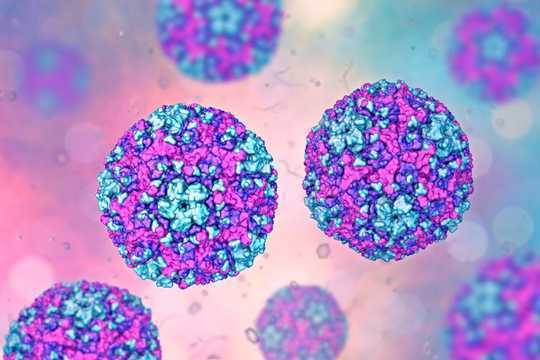
Coxsackievirus. Kateryna Kon/Shutterstock
Non-muscle invasive bladder cancer is the tenth most common cancer in the UK and is difficult to treat. Current treatments are invasive and often have unpleasant side effects. The cancer also has a high recurrence rate – often returning in a more aggressive form.
We wanted to see if an unusual therapy – a virus that causes the common cold – could be successful in treating this kind of cancer. It is the first time this therapy has been attempted, and we couldn’t have been happier with the results. We treated 15 people with stage 1 bladder cancer with the virus and in just one week, 14 of them saw their tumour shrink. The remaining patient had no sign of the disease at all. And the cherry on top was that there were no serious side effects.
The cancer-killing coxsackievirus used in our study had been used to treat skin cancer in earlier studies, but we wanted to test its potential for treating non-muscle invasive bladder cancer. We urgently need a more effective, less invasive treatment for this disease, and our study, published in Clinical Cancer Research, suggests that coxsackievirus may be that treatment.
From bacteria to viruses
About 10,000 people are diagnosed with non-muscle invasive bladder cancer in the UK each year. The first step in treating these patients is to remove the wart-like cancerous growths in the lining of the bladder. For some people this is enough, but for others the removed cancer tissue suggests that they are at high risk of recurrence and a more invasive cancer. For these people, treatment often comes in the form of live tuberculosis bacteria (BCG).
BCG was first used as a treatment for bladder cancer in the 1970s. It works by infecting the bladder which then prompts immune cells to head to the site of the infection and attack the cancer cells. The problem with BCG is that it is difficult to manufacture and the treatment has severe side effects – including pain, bleeding and fever – because it inflames the whole bladder.
Treatment with coxsackievirus is different in that it is limited, local and has few side effects.
The immune environment in the bladder lining – where non-muscle invasive bladder cancer takes hold – is poorly understood. We know it’s not highly evolved and so the lining offers limited protection against cancer.
Unlike cancer therapies that are injected into the bloodstream (such as chemotherapy), bladder-directed therapy (the therapy we used) has the advantage of treating cancer directly and locally. A catheter is inserted into the bladder and the virus is infused into the bladder for an hour. It is then possible to take regular urine samples to see if dead cancer cells are being shed.
 Blood in your urine is the most common symptom of bladder cancer. Lesterman/Shutterstock
Blood in your urine is the most common symptom of bladder cancer. Lesterman/Shutterstock
Coxsackievirus is a small, fairly primitive virus that needs an anchor to infect and enter cells. This anchor is a protein called ICAM-1, which is found at very low levels in some normal tissue but at very high levels in bladder cancer.
Earlier lab tests have shown that coxsackievirus kills cancer cells quickly and abundantly. Previous viruses considered for bladder cancer therapy did not have specific targets, were genetically modified (coxsackievirus occurs in nature) and patients in previous trials were treated after their tumours were removed, so there was no tissue available to measure the effects of the virus.
Once inside cancer cells, coxsackievirus replicates and kills the host cell. Normal cells are able to extinguish the virus if it does get in as they have a natural antiviral response (cancer cells have lost this ability). The replicating virus can then enter neighbouring cancer cells and so amplify its anti-cancer effect.
Viral factories
As the tumours become viral factories, the viruses stress the cells before killing them. This results in the infected cancer cells sensing danger and switching on a wide range of proteins to alert the immune system. We saw evidence of all of these features in the tissue samples, and production of these “immunogenic” proteins cause an influx of a vast array of immune cells, which are primed and effective cancer killers.
The fact that none of our patients experienced side effects after the viral infusion suggested to us that the virus was only attacking cancerous cells and leaving healthy cells intact. This was confirmed post-surgery when we examined the removed tissue.
This treatment could potentially be used in two-thirds of all patients seen each year who have more aggressive forms of this disease, but we now need larger studies to confirm our findings. We hope to lead these in the UK with several other cancer centres.![]()
About the Author
Hardev Pandha, Professor of Medical Oncology, University of Surrey
This article is republished from The Conversation under a Creative Commons license. Read the original article.






















